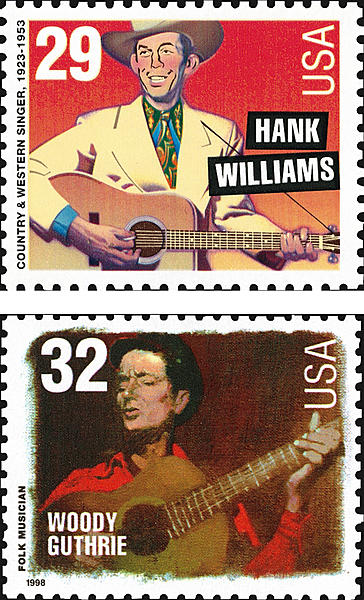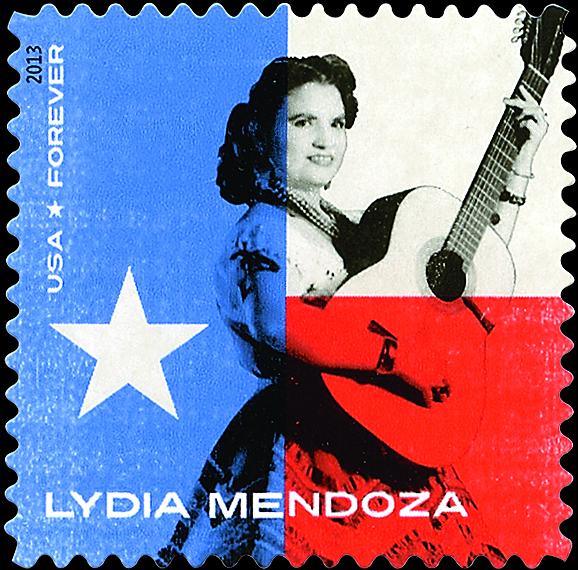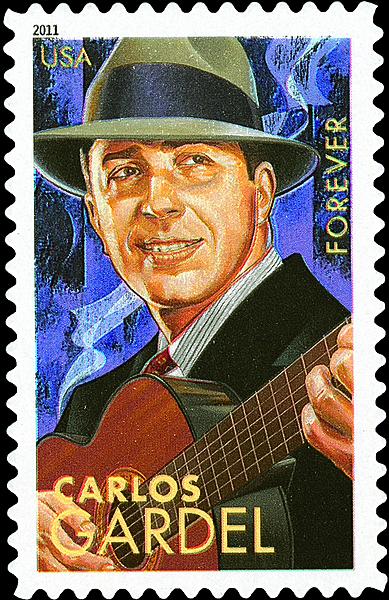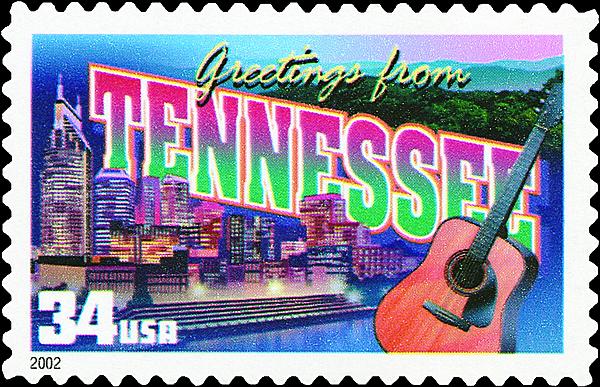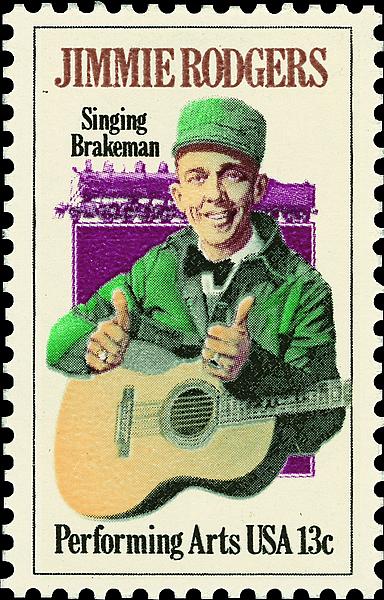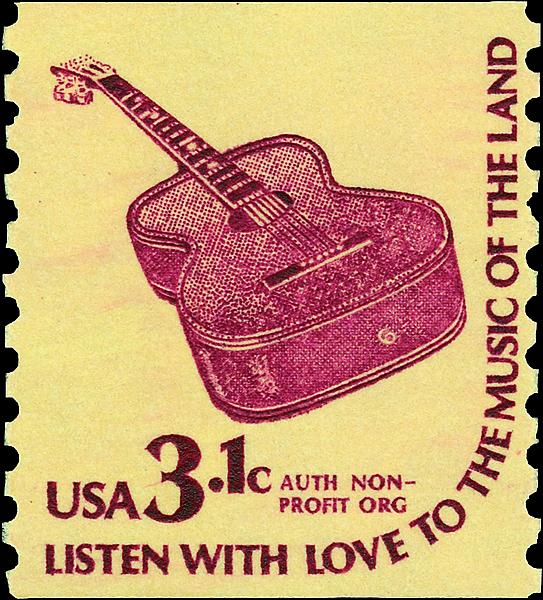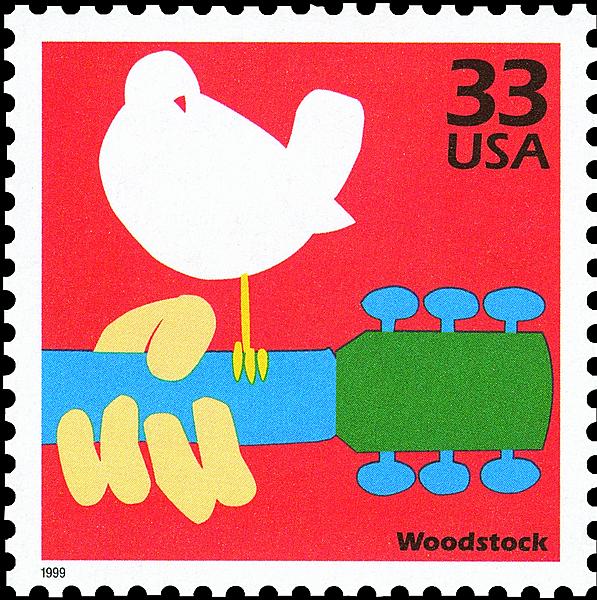US Stamps
Guitars on United States stamps celebrate the broad range, variety of American music
The Jimi Hendrix forever stamp issued March 13 (Scott 4880) is the latest United States stamp to include a guitar in the design.
The illustration by artist Rudy Gutierrez is a fanciful one. The guitar and its neck gently curve upward in harmony with other swirling design elements that evoke the psychedelic era of the 1960s.
A curving neck on a real guitar would be a tragedy for any guitar owner, but for all of the artistic license taken by Gutierrez, some characteristics of the guitar he depicted are very accurate.
The white electric guitar in Hendrix’s hands is a Fender Stratocaster with a maple neck, representing the 1968 Stratocaster that Hendrix played at Woodstock in 1969.
The guitar in the stamp is a right-handed model, but is being played by Hendrix left-handed, actually positioning the guitar upside down. This, too, is accurate.
Hendrix, though left-handed, played right-handed guitars flipped over and restrung so that the bass strings were still on top as they normally would be.
The real Hendrix guitar did not have a red outline on the body or neck, as is shown on the stamp; that’s just a little more artistic license.
The U.S. Postal Service offered two pictorial first-day cancels for the Hendrix stamp, one in black and one in full color, that also depict a guitar. The stylized silhouette on these cancels might be intended to show a Stratocaster, but the elements are distorted enough that it’s impossible to tell for sure.
The commemorative for Hendrix is not the first U.S. stamp to recall the famous Woodstock music and arts festival. A pane of 15 33¢ stamps issued in 1999 commemorates the decade of the 1960s as part of the Celebrate the Century series, with one stamp from the pane specifically celebrating the Woodstock event (Scott 3188b).
The stamps in that set were designed by Carl Herrman and illustrated by Keith Birdsong, but the Woodstock stamp borrows heavily from the popular Woodstock poster designed by Arnold Skolnick.
In that design, a white dove is perched on the neck of an acoustic six-string guitar that is being fingered by the left hand of the player.
Only the neck and the headstock of the guitar are shown on the poster, and on the stamp.
The Woodstock stamp was the second from the Celebrate the Century series to show a guitar.
The first was the 33¢ Rock ’n’ Roll stamp from the 1950s pane (Scott 3187m). The rocker portrayed in the original artwork by Dean Ellis is playing a black six-string acoustic guitar.
An acoustic guitar was featured prominently 10 years after Woodstock, and 20 years before the 33¢ Woodstock stamp, on a 1979 3.1¢ coil stamp created to fulfill a reduced postage rate for authorized nonprofit organizations, the first U.S. stamp to do so.
The stamp (Scott 1613) is part of the 1975-81 Americana definitive series, and as such, includes a line of text curling around two adjoining sides of the design, in this instance reading, “Listen with love to the music of the land.”
The coil stamp was designed by George Mercer, his first for the Postal Service.
The guitar depicted “is a composite of several types of standard six-string guitars,” the Postal Service noted in its philatelic release No. 67 distributed Oct. 1, 1979. “It does not portray a specific model or type.”
The vignette was engraved by Gary M. Chaconas, with lettering engraved by Albert Saavedra.
A stamp issued one year earlier also shows an acoustic guitar, along with a man who became famous playing it and singing: Jimmie Rodgers, popularly known as both the Singing Brakeman and as the father of country music.
The 13¢ Jimmie Rodgers stamp in the Performing Arts commemorative series (Scott 1755) shows the Martin 000-45 guitar he played during much of his brief life (he died at age 35).
It’s the same guitar, with his name inlaid in block letters in the ebony fingerboard, that he’s holding in a popular 1929 “thumbs up” publicity photograph that is nearly identical to the pose shown on the stamp.
An enlarged USPS publicity photo distributed when the stamp was issued clearly shows the distinctive fingerboard lettering.
Guitar manufacturer C.F. Martin and Co. refers to Rodgers’ original Martin as “possibly the most valuable (if not priceless) guitar ever made.” The guitar is on permanent display at the Jimmie Rodgers Museum in Meridian, Miss., where the stamp was officially issued in 1978.
Another country music legend, Hank Williams, was honored on four 29¢ stamps sharing the same design in 1992-93 (Scott 2723, 2723A, 2771 and 2775).
The Hank Williams stamp was one of the first issues in the new American Music commemorative stamp series that would continue for more than seven years and honor almost 80 different musicians, groups and musicals in a number of stamp sets arranged by genre.
The Hank Williams stamp shows him playing his Martin D-28 acoustic guitar, which is now owned by his son, musician Hank Williams Jr., and which has been exhibited at the Country Music Hall of Fame and Museum in Nashville, Tenn.
That lengthy American Music stamp series includes several additional stamps that picture at least part of a guitar.
Bill Haley (Scott 2725, 2732) is shown with his Gibson Super 400 electric guitar, Buddy Holly is rocking a Fender Stratocaster (2729, 2736), and Maybelle Carter is playing a 1928 Gibson L-5 acoustic guitar on the Carter Family stamp (2773, 2776).
The acoustic guitar in the original 1930s black-and-white photograph used as the model for the 1994 Robert Johnson stamp (Scott 2857) is believed to be a Kalamazoo model KG-14, according to the online Blueheart Archive and other sources.
The Kalamazoo guitar was a budget-line instrument manufactured by Gibson.
The Folk Singers set in the American Music series includes tributes to Woody Guthrie (Scott 3213) and Josh White (3215) on 32¢ stamps that show each man playing a six-string acoustic guitar.
Both of these instruments are difficult to identify.
The source photograph for the Woody Guthrie stamp artwork suggests the guitar might be a Martin 0-17, but Guthrie was known to have owned and played many different guitars, and he often sold them or gave them away.
The 32¢ Woody Guthrie stamp was issued in 1998.
A photograph similar to the 32¢ Josh White stamp design shows White playing a Martin as well, but the depiction on the stamp is inconclusive.
One of the more unusual guitars on a U.S. stamp is the 1930s National Triolian resonator guitar with flat-cut “f” holes held by Sister Rosetta Tharpe on the 32¢ stamp honoring her in the 1998 Gospel Singers set (Scott 3219). As its name suggests, a resonator guitar is manufactured with a spun metal cone that resonates the notes played and provides a distinctive tone.
Resonator guitars are particularly popular in blues and bluegrass music.
It’s a shame that more of this intriguing instrument isn’t visible on the stamp (only a section of the neck and headstock can be seen). The guitar is fully visible on the Tharpe publicity photo and Decca Records album cover art that served as a model for the stamp.
The Greetings from America stamp set was issued with 50 different designs representing the 50 U.S. states.
Each stamp contains different design elements featuring characteristics of the state being celebrated. The artwork was created by illustrator Lonnie Busch using software programs on a personal computer.
The original pane of 50 was issued April 4, 2002, with 34¢ denominations (Scott 3561-3610). Following a letter-rate change at the end of June, the popular set was issued again Oct. 25, this time with 37¢ denominations (3696-3745).
The state of Tennessee is home to dynamic music centers in both Memphis and Nashville, and a blonde acoustic six-string dreadnought guitar is shown on the stamp for Tennessee in the Greetings from America set.
Asked about the guitar depicted, Busch replied that he purposely changed many details so that a particular guitar brand would not be recognizable.
Another six-string, this one made of a darker wood, is depicted on the forever stamp honoring musician Carlos Gardel (Scott 4500), issued in 2011 as part of the Latin Music Legends set.
Referred to by NPR as “Argentina’s tango maestro,” Gardel most likely played a nylon-string guitar, though he worked with several other guitarists who accompanied him over the years.
But the portrait on the stamp does not picture Gardel playing his own guitar: The instrument depicted belongs to artist and musician Rafael Lopez, who illustrated the stamp.
“I couldn’t find a photo of him playing the guitar at the perfect angle,” the U.S. Postal Service quotes Lopez as saying, “so I asked my wife to take a photo of me playing the guitar. Basically, what you see in the stamp is my guitar and hands with a photo of Gardel.”
The 2013 Music Icons series that offered the Jimi Hendrix stamp in 2014 has so far honored two additional musicians known for their guitar playing: country music’s Johnny Cash (Scott 4789) and Tejano star Lydia Mendoza (4786).
The Johnny Cash stamp shows only a stark headshot of “the Man in Black,” with no guitar in sight.
The Lydia Mendoza stamp, however, reproduces a 1950s black-and-white publicity photo of the popular singer, holding her 12-string acoustic guitar, the guitarra doble.
Future stamps in the ongoing Music Icons series are expected to honor, among others, John Lennon and Elvis Presley. Both played acoustic and electric guitars, but the stamps, if issued, won’t necessarily show them with an instrument.
According to information reported late last year by the Washington Post, a stamp (or stamp set) featuring guitars as a subject has been approved by the Citizens’ Stamp Advisory Committee, but as of Jan. 7, the subject reportedly was not yet in design development.
MORE RELATED ARTICLES
Headlines
-
US Stamps
Oct 7, 2024, 3 PMMcMurtrie dismissed as APS education director following Sept. 21 arrest
-
US Stamps
Oct 7, 2024, 12 PMVasiliauskas named president of Mystic Stamp Co.
-
US Stamps
Oct 6, 2024, 5 PMApgar souvenir card available
-
US Stamps
Oct 6, 2024, 4 PMFirst Continental Congress and U.N. stamps receive Scott catalog numbers
